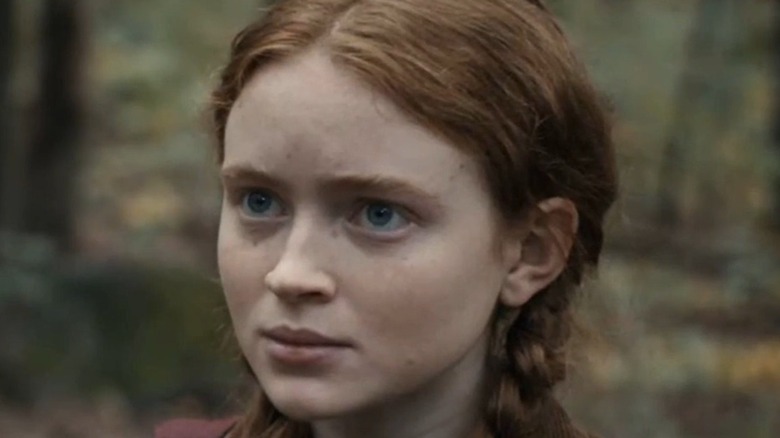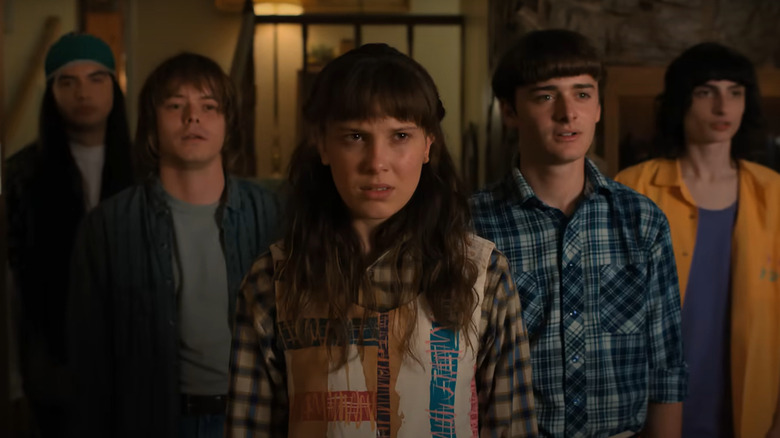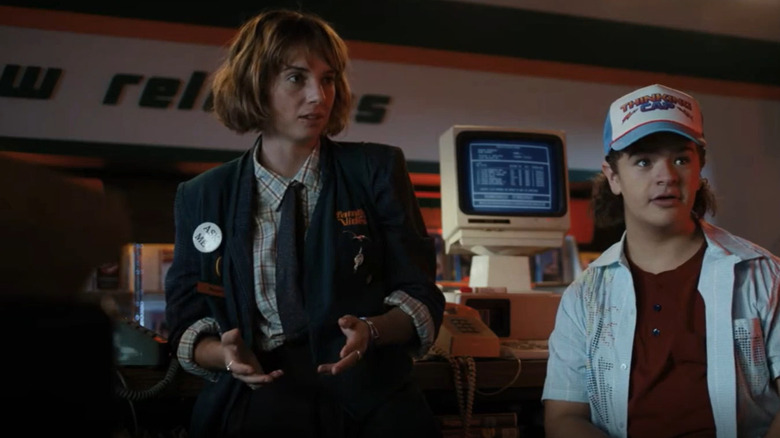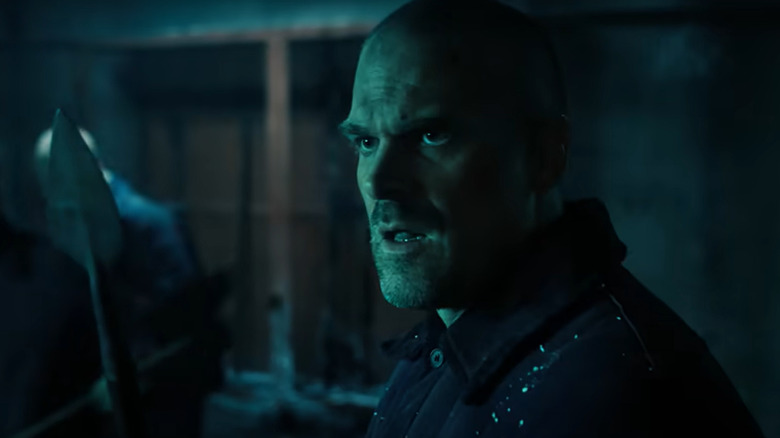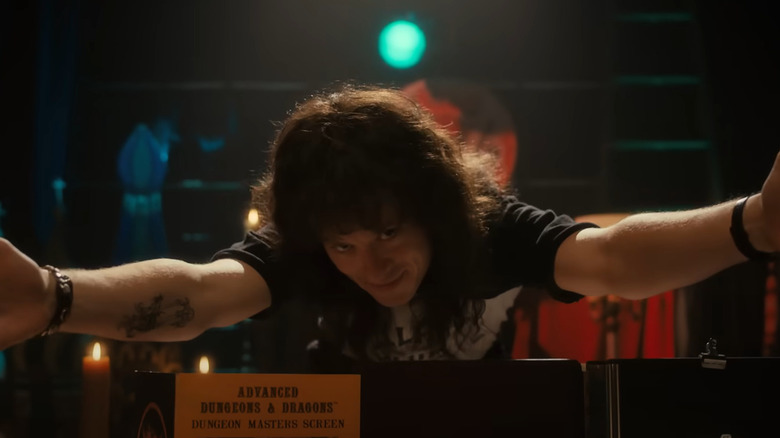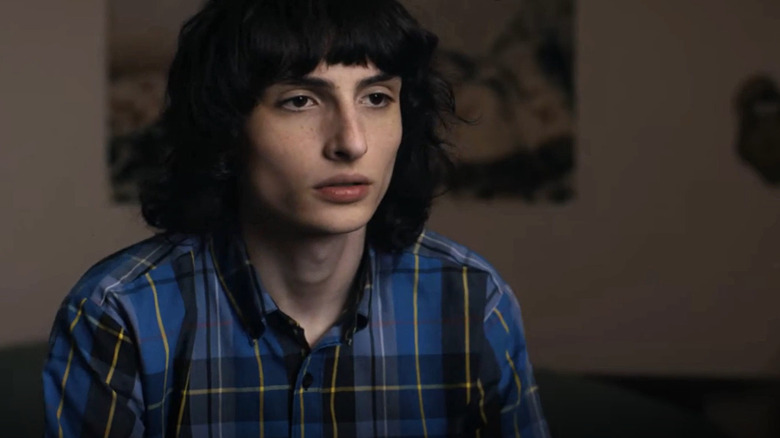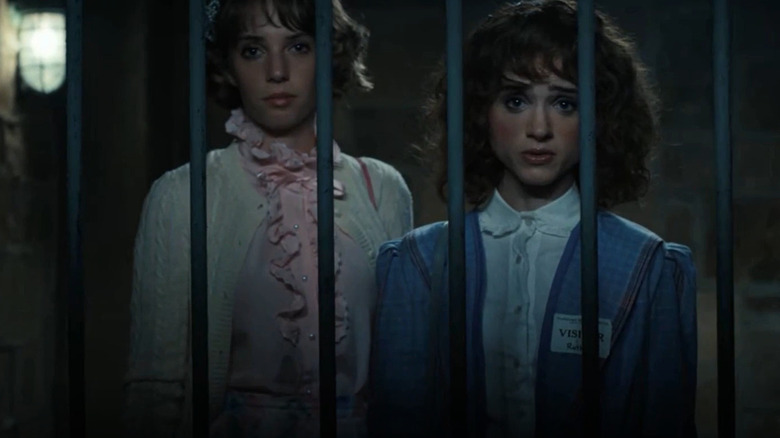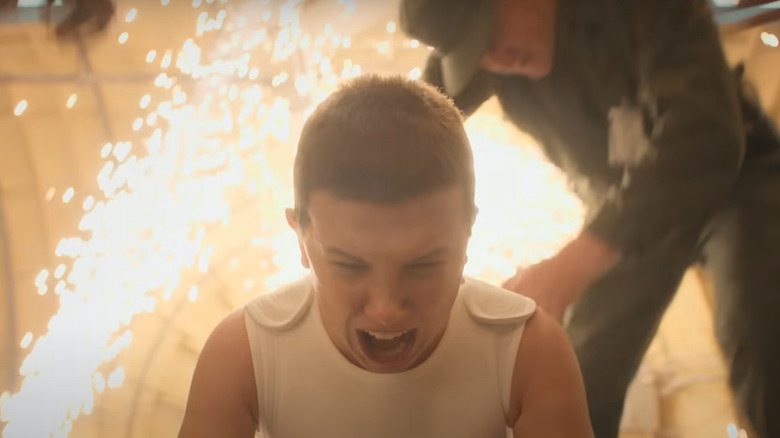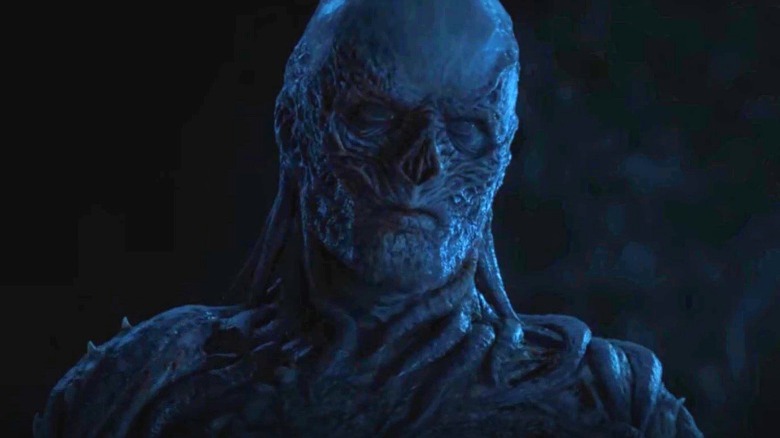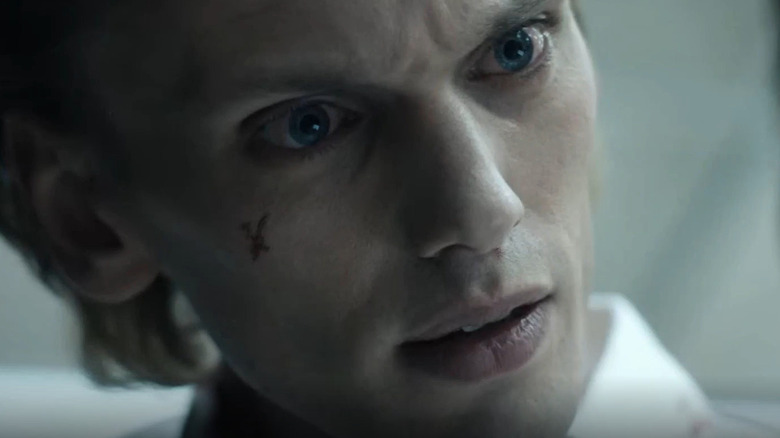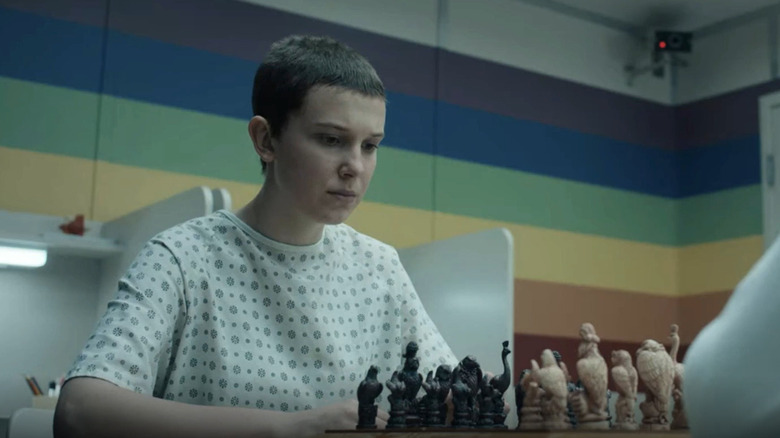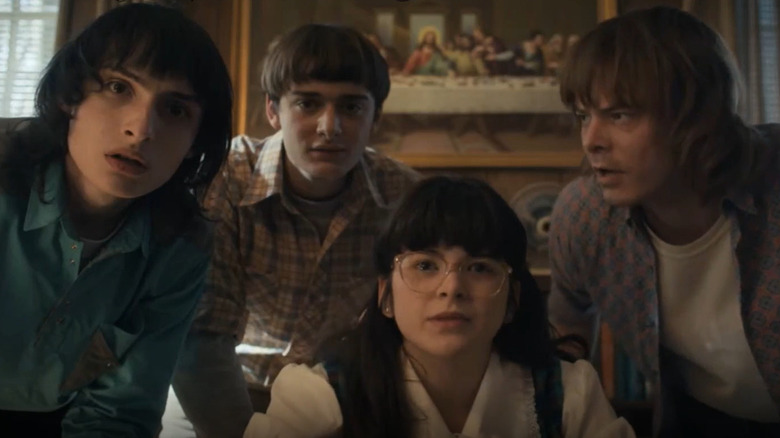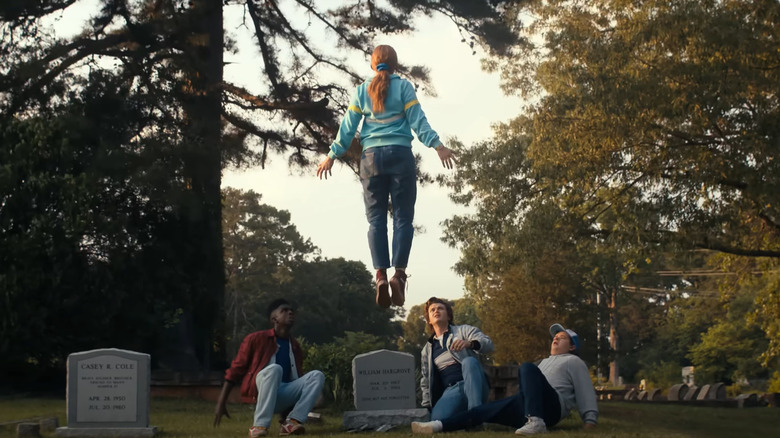The 6 Best And 6 Worst Things About Stranger Things Season 4 Part 1
The wait was long, but "Stranger Things" Season 4 is finally here — at least, most of it is. Netflix's retro sci-fi horror powerhouse has been split into two volumes for its fourth installment, with the first seven episodes dropping several weeks ahead of the last two. Fortunately, the Season 4 episodes are so long — averaging over 70 minutes apiece — that the first seven alone still provide plenty of twists, scares, and touching character moments. It's nice to see the Duffer brothers delivering such a substantive addition, but what's even nicer is that Season 4 is some of the best "Stranger Things" yet.
Set about six months after Season 3, which saw the core characters scattered to the wind, the new set of episodes — officially titled "Stranger Things 4" Volume 1 by Netflix — expands the show significantly. For the first time, there are multiple storylines taking place simultaneously all over the globe. Only some of the season's first seven episodes take place in Hawkins, as time must be allotted to plotlines in Nevada, California, Alaska, and Russia.
With so much new ground to cover, growing pains are inevitable, and "Stranger Things 4" has its fair share. The narrative balance often feels uneven, some writing choices feel shoehorned in, and Season 4 is arguably the show's most derivative yet. For the most part, though, "Stranger Things 4" Volume 1 is a triumph — a meaningful expansion of the world that opens up exciting possibilities. Here are the best things about the season's first set of episodes, as well as the choices that hold it back.
Be warned, there will be major spoilers ahead.
Worst: Too many tropes
"Stranger Things" has always worn its '80s influences on its sleeve. From the classic horror movies it takes inspiration from to the use of "Dungeons & Dragons" verbiage to describe supernatural occurrences, the show's constant stream of retro Easter eggs and homages is a big part of its appeal. That '80s influence extends to the show's narrative structure, with many plot twists and character deaths fitting into classic tropes from the era.
Unfortunately, "Stranger Things 4" Volume 1 dips into that arsenal of tropes a bit too much. Eleven's scenes in the first few episodes are a great example of this. After losing Hopper and moving away from Hawkins, she feels isolated and depressed. However, rather than show this through some more grounded moments of mourning — which Millie Bobby Brown has proved that she's more than capable of — the show resorts to a series of over-the-top bullying scenes à la "Carrie" or "The Karate Kid." In a show where bullies have almost always been fleshed out with complex character traits, these moments feel lazy.
There are plenty of other times when the tropes work against the show. Despite having been in numerous supernatural situations before, the gang keeps leaving their backpacks and radios on the floor and walking away. Government agents come off as cold and evil because — they're the bad guys? Perhaps worst of all, several poignant emotional moments are undercut by overwrought writing. But more on that later.
Best: The 1980s
Despite an occasional over-reliance on tropes, "Stranger Things" Season 4, Volume 1 still mostly uses its '80s influences to its advantage. From the lavishly retro sets and costumes to the synth-ridden soundtrack and the aesthetic of the horror itself, the new season gets a lot of mileage out of the decade. Beyond that, it looks and sounds amazing while doing so. Given that each episode in Season 4 cost a reported $30 million to make, that should come as no surprise (per The Wall Street Journal).
"Stranger Things" Season 4 uses its '80s setting for more than just style and aesthetic, however. Volume 1 includes quite possibly the best use of the decade yet by bringing the Satanic Panic to the forefront of the story. After three seasons of mysterious deaths and tragedies, the people of Hawkins settle on the only reasonable explanation — that the high school "Dungeons & Dragons" club is actually a cult, and its members have brought the Devil himself to town. In the world the Duffers have built, it's the perfect twist — a beautiful, hilarious, and dark combination of the show's love of '80s nerd culture, occult flavor, and smart sense of humor.
There are some other standout '80s moments, like Robin using the customer directory at a video rental store to identify a person of interest based on the movies they like. And, of course, the soundtrack is amazing. At this point, though, that should go without saying.
Worst: Too long
No matter how popular your show is, bumping episode lengths from 45 minutes to 75 minutes (and in some cases even longer) is a bold move. The whole pace changes, the structure of the story shifts, and there is suddenly way more room for missteps and dullness. The good news is that "Stranger Things 4" Volume 1 rarely drags, even in its longest episodes. The cast — which has always been the show's saving grace — continues to deliver, making every scene entertaining in at least some minor way. Season 4 does a good job of balancing the growing danger of the Upside Down with more independent character arcs, and things generally stay fresh and exciting.
However, there are definitely some scenes that feel less essential than others, and they can occasionally give the impression that the show is padding out its best content. Do we need three different scenes of Eleven being bullied? Do we need Hopper to visit three different Russian prisons? Or the prolonged "Home Alone" homage at Suzie's house in Utah? These inclusions don't ruin the season by any means, and because so much of the material around them is so strong, you might not even notice when the momentum dips. However, it does indeed dip, and it dips hard. Just because a scene doesn't wreck your episode doesn't mean it needs to be included, which is a lesson that "Stranger Things 4" hasn't quite learned.
Best: New characters, new arcs
You could argue that even by the end of Season 3, "Stranger Things" had too many characters. The original crew of Mike, Will, Dustin, Lucas, and Eleven eventually added Max and Erica, then Suzie. Then there are the older kids: Steve, Nancy, Jonathan, Robin, and Billy, among others. Plus Joyce, Hopper, Murray, Dr. Owens, and Dr. Brenner. At a certain point, every episode is so loaded with people that they each only get a few moments to shine.
How, then, could the introduction of even more characters be one of the best things in "Stranger Things" Season 4? Well, the extended runtimes don't hurt. Beyond that, every new addition to the cast is carefully selected and serves a specific purpose. Joseph Quinn's Eddie Munson is phenomenal as Hawkins' supposedly Satanic scapegoat. Mason Dye is equally stellar as the town's mob-making, speechifying golden boy Jason Carver. Eduardo Franco's Argyle adds some much-needed comic relief to a relatively dour season, and of course, slasher film fans will be excited to see Freddy Krueger himself, Robert Englund, cameo as the enigmatic Victor Creel.
Still, the season's best material is reserved for the main "Stranger Things" characters. Robin gets to annoy Nancy and explore her gay panic in adorable ways. Lucas is torn between his old, nerdy friends and his new, cool friends. Charlie Heaton has a field day with Jonathan Byers' new habit of smoking reefer, and Hopper ditches his goofy dad persona in favor of a much meatier arc. The real star of Volume 1, however, is Sadie Sink as Max Mayfield, who acts circles around the rest of the cast with deftness and skill.
Worst: Mike Wheeler
Sadly, one "Stranger Things" character who doesn't make any big leaps in the first volume of Season 4 is Mike Wheeler, who has been little more than a punk since he hit puberty. Finn Wolfhard has fantastic onscreen energy when he's allowed to show it, but unfortunately, "Stranger Things 4" Volume 1 traps him in the same suffocating box where he languished for most of Season 3. He gets to complain while being lousy to his friends, and that's about it.
It's not that Mike's unlikable teenage persona is unbelievable. In fact, it's perhaps one of the most realistic character portrayals in the show. However, when characters like Will and Eleven repeatedly insist that Mike is worth their time, things start to fall apart. As long as Mike keeps behaving like a jerk, his relationship with El will continue to feel artificial. Yes, they have shared trauma, and yes, they were kind to each other as kids, but "Stranger Things" desperately needs to show why they want to date each other now, as teenagers. So far, the show has done a pitiful job.
The good news is that Mike does show some signs of redemption toward the end of "Stranger Things 4" Volume 1. He apologizes to Will for being a bad friend, and he's forced to face his emotional insecurities with El. It remains to be seen if the end of Season 4 will make good on that potential, but for Wolfhard's sake, and that of the audience, we can certainly hope.
Best: The Hawkins storyline
Of the numerous storylines balanced in "Stranger Things" Season 4, it shouldn't be a surprise that the Hawkins arc is the best one by far. A majority of the main cast remains in Hawkins, and because the town has been the singular focus up until this point in the story (with a few exceptions), there's way more preexisting material to play with.
For starters, the Hawkins arc is the main setting for the actual horror of Season 4, Volume 1. Vecna, the new big bad of the Upside Down, conducts his murderous rampage entirely within the town limits. The villain's "A Nightmare on Elm Street" inspired plotline is a lot of gruesome fun and brings a distinctly different twist to the show's previous Upside Down threats.
In addition to Vecna, Hawkins hosts some of the most compelling personal character arcs in "Stranger Things 4." Maya Hawke's Robin gets to really shine after coming out in Season 3, bringing a unique breed of manic comic relief to the horrifying proceedings. Steve, Dustin, Nancy, Lucas, and Erica also all get quality screen time together, retaining the ensemble feel of earlier seasons despite the relative isolation of the season's other storylines. Perhaps best of all, though, is the Satanic Panic arc in Hawkins, led by two excellent performances by Joseph Quinn and Mason Dye. Even when the season's other plotlines are revving up with revelations and intrigue, you'll likely find your mind wandering back to whatever's happening in Hawkins.
Worst: The Eleven storyline
It's not a controversial statement to say that Millie Bobby Brown's Eleven has been the show's focal point. She is essentially the main protagonist. Given all of her history, it's a shame that Eleven's arc in "Stranger Things 4" Volume 1 feels so mismanaged.
To start, the season does a sloppy job of conveying just how depressed El is. She thinks that Hopper, basically her father, is dead, she loses her powers through a series of traumatic experiences, and she moves to an entirely different state where she only knows Will, Jonathan, and Joyce. That's plenty of material to build a compelling and heartwrenching starting point for Eleven in Season 4, but the writers instead focus on a series of overwrought bullying scenes with generic characters. It's as if the creators somehow lost faith in the material they'd already written for Eleven and decided to force even more hardship on her instead of working with what they already had. This does a huge disservice to both the audience and Millie Bobby Brown.
Similar problems abound once Eleven reaches her underground training center, where she reunites with Dr. Brenner. Her complete regression to her Season 1 self is somewhat interesting, but it goes too far. Why would she still call him "Papa," for instance, after all she's been through? The answer is simple –- for forced dramatic effect. The problem isn't that she agrees to work with Brenner again but that she seems to lose all sense of herself in the process. This should have been a great chance for the writers to show how much Eleven has changed since her Season 1 escape, but they blow it.
Best: The Vecna mystery
Since "Stranger Things" Season 1, the show has been largely iterative in its horror. The Demogorgon gave way to the Mind Flayer, which was essentially a bigger, smarter Demogorgon. The zombie storyline in Season 3 brought some new ideas, but in the end, it still amounted to another big, gooey monster. Given the infinite mystery of the Upside Down, there's been plenty of room for the writers to play around with other kinds of monsters and supernatural threats. Thankfully, "Stranger Things 4" finally makes that happen.
Despite pulling most of his interesting qualities directly from Freddy Krueger, Vecna still feels unique and fresh in the context of "Stranger Things." His pursuit of Max, in particular, is legitimately frightening, and his more humanoid persona makes him even more terrifying. The whole backstory element of the Creel family and their haunted house is equally compelling, and it gives the Hawkins crew a lot of interesting challenges to grapple with. In short, Vecna is exactly what "Stranger Things" needed — a new kind of supernatural threat that expands the possibilities of the Upside Down and brings a different tone than the previous seasons.
However, Vecna's many strengths make it even more disappointing that the revelation of Vecna's true identity at the end of Episode 7 is handled so poorly.
Worst: The Vecna twist
Even if you've watched all of "Stranger Things 4" Volume 1, you might still be confused as to how all the pieces fit together, so here's a quick rundown.
Victor Creel's son was a psychic of terrifying power who tormented and ultimately murdered the rest of his family. He was then apprehended by Dr. Brenner, who wanted to train and harness his abilities. When he realized that the boy couldn't be controlled, he began a secret program designed to produce other psychic children like him. The Creel boy, now called "One," has his powers blocked, but he later tricks Eleven into freeing him, and he massacres everyone in Brenner's lab. Then Eleven banishes him to the Upside Down (somehow), where his body is deformed by lightning, transforming him into Vecna.
That's a pretty longwinded explanation, but it's nothing compared to the clunky mountain of a monologue that One delivers via flashback to Eleven. It's the classic mistake of setting up too much in a single scene, and the result is that the payoff — a revelation that should be cool and intriguing — just feels confusing. Where has Vecna been for the last three seasons? Why hasn't he brought his powers to bear sooner? Why is his story told in the most awkward and contrived way possible? It's a bummer ending to an otherwise excellent set of "Stranger Things" episodes. Hopefully, Volume 2 can stick the landing with some compelling explanations and make all these complaints moot.
Best: The big picture
Despite its flaws, Season 4 makes arguably the most significant changes to "Stranger Things" the series has seen since it began. The numerous locations and storylines expand the show's world in meaningful ways, giving different characters time to breathe away from one another in the process. The Upside Down feels scary again, and there are a ton of new mysteries pertaining to its exact nature. New supporting characters like Argyle and Dmitri help to reveal new sides of mainstays like Jonathan and Hopper, and the ramifications of what happens in Hawkins are brought to bear on a much larger stage.
"Stranger Things" has grown with each successive season, but up until now it's still retained a tight focus on Hawkins. That made the show feel bloated at times, with too many characters in too small a space. Season 4 gives the show the room it needs to fully embrace its current roster and scope, and that expansion allows for even more diversity in style and tone. "A Nightmare on Elm Street" is definitely the main inspiration for Volume 1, for instance, but there are also clear homages to "The Silence of the Lambs," "Home Alone," "Red Dawn," and "The Great Escape," among others. The Duffers have always shined brightest when combining their influences, and the massive scale of "Stranger Things 4" allows them to do that even more.
Worst: Uneven
While the narrative expansion of "Stranger Things" Season 4 is mostly a good thing, it occasionally results in some problems. A chain is only as strong as its weakest link, after all, and now "Stranger Things" has so many arcs happening simultaneously that the messier ones stick out like a sore thumb.
This is particularly visible in the sloppy writing for Eleven's storyline, but it rears its head elsewhere as well. The revelation of Vecna's identity feels rushed, even though the show has nearly nine hours to build up to it. Then there's the matter of Dustin's girlfriend Suzie, who was of debatable relevance in Season 3 and feels even more out of place in Season 4. Young star Gabriella Pizzolo does a great job in the role, but it is the role itself that is the problem. In a season where teens are getting turned inside out by dark magic and Eleven is forced to relive her most traumatic moments in Technicolor, Will and Mike's journey to Suzie's house in Utah feels wildly out of place. There's merit in lightening the mood with some comic relief, but Suzie's bizarre family situation feels infinitely more jarring than it does entertaining — a blown-up version of Season 3's baffling "Never Ending Story" singalong.
Again, these sorts of uneven moments are inevitable in a season that tries to do so much. There are far more great moments than bad ones, but it's hard not to notice when the quality dips.
Best: Sadie Sink
Sadie Sink is the best part of "Stranger Things 4" — full stop. After being introduced in Season 2 and becoming part of the core crew in Season 3, Max Mayfield finally gets a full arc in Season 4, Volume 1, and it blows everything else out of the water.
After she watches her stepbrother Billy (Dacre Montgomery) sacrifice himself during the Battle of Starcourt Mall, Max's life doesn't get much better. Billy's dad leaves her and her mom, forcing them into a trailer park. Max's mom has to take on extra work to cover the bills and starts drinking to cope with her grief. As a result, Max pushes her friends away — even Lucas — and buries herself in a dark cycle of grieving and guilt. Since Vecna feeds on those negative emotions, Max becomes one of his targets.
Fast-forward to Episode 4, "Dear Billy," where Sink delivers a truly captivating performance. She reads a letter to Billy at his grave, finally putting words to all of her trauma. Then, Vecna strikes. He tells Max that she's weak, guilty, and deserves to die. But her friends are there to help, and they start blasting Max's favorite song in her ears to try to break her trance. What follows is one of the best moments "Stranger Things" has ever produced.
Max runs, trying with all her might to escape Vecna's world while Kate Bush's "Running Up That Hill" booms in the background. It's a triumph of audiovisual storytelling on par with the "Elegia" montage from Season 1 and Will's destruction of Castle Byers in Season 3. Sink anchors the whole thing with emotional acting, delivering a powerful reminder that no matter how dark things get, it's still possible to get out of a bad place.
